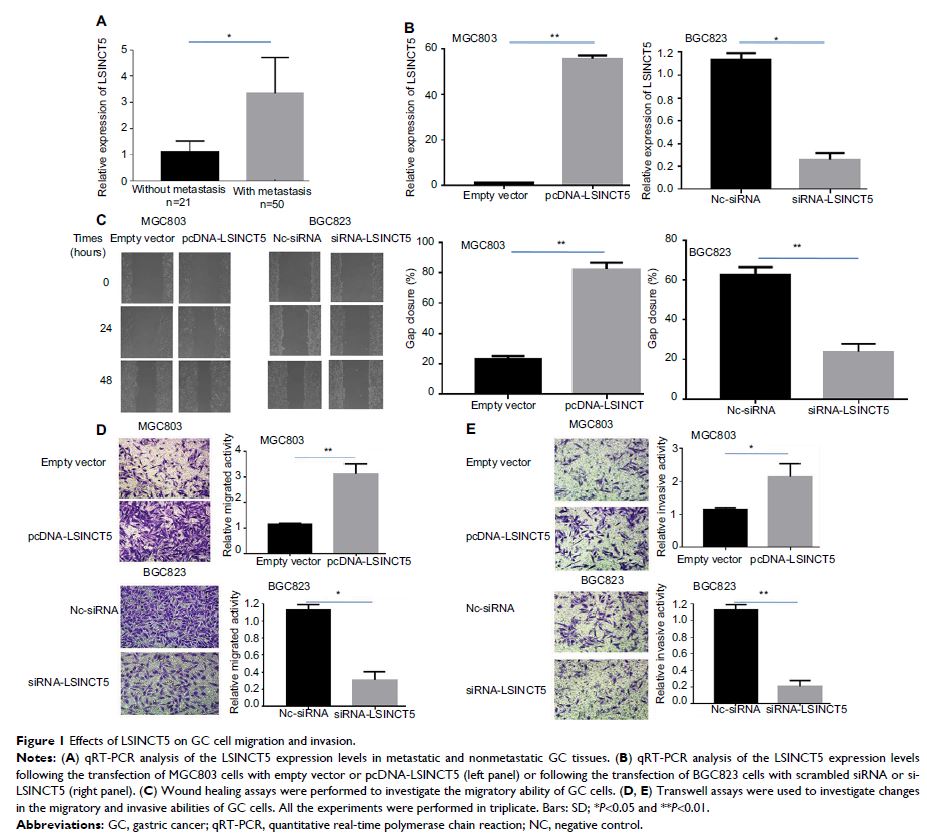9 0 5 7 8
论文已发表
注册即可获取德孚的最新动态
IF 收录期刊
- 2.6 Breast Cancer (Dove Med Press)
- 3.9 Clin Epidemiol
- 3.3 Cancer Manag Res
- 3.9 Infect Drug Resist
- 3.6 Clin Interv Aging
- 4.8 Drug Des Dev Ther
- 2.8 Int J Chronic Obstr
- 8.0 Int J Nanomed
- 2.3 Int J Women's Health
- 3.2 Neuropsych Dis Treat
- 4.0 OncoTargets Ther
- 2.2 Patient Prefer Adher
- 2.8 Ther Clin Risk Manag
- 2.7 J Pain Res
- 3.3 Diabet Metab Synd Ob
- 4.3 Psychol Res Behav Ma
- 3.4 Nat Sci Sleep
- 1.9 Pharmgenomics Pers Med
- 3.5 Risk Manag Healthc Policy
- 4.5 J Inflamm Res
- 2.3 Int J Gen Med
- 4.1 J Hepatocell Carcinoma
- 3.2 J Asthma Allergy
- 2.3 Clin Cosmet Investig Dermatol
- 3.3 J Multidiscip Healthc

E2F1 通过影响上皮 - 间质转化诱导 LSINCT5 转录活性并促进胃癌发展
Authors Qi P, Lin W, Zhang M, Huang D, Ni S, Zhu X, Bai Q, Sheng W, Du X, Zhou X
Received 19 April 2018
Accepted for publication 14 June 2018
Published 10 August 2018 Volume 2018:10 Pages 2563—2571
DOI https://doi.org/10.2147/CMAR.S171652
Checked for plagiarism Yes
Review by Single-blind
Peer reviewers approved by Dr Cristina Weinberg
Peer reviewer comments 2
Editor who approved publication: Dr Antonella D'Anneo
Background: Long noncoding RNAs (lncRNAs) have been shown to play important
regulatory roles in human cancer. We previously verified that the lncRNA long
stress-induced noncoding transcript 5 (LSINCT5) is overexpressed in gastric
cancer (GC) cells and closely correlated with cell proliferation and patient
prognosis. However, whether aberrant LSINCT5 expression has an important effect
on GC progression is unclear, and the potential mechanisms remain unknown. In
GC, E2F1 expression is also aberrant, but the biological functions of E2F1 are
controversial, and the correlation between E2F1 and lncRNAs remains unknown.
Materials and methods: Expression of LSINCT5 was analyzed in metastatic
GC tissues compared with nonmetastatic tissues using quantitative real-time PCR
(qRT-PCR) assays. Gain and loss of function approaches were used to investigate
the biological role of LSINCT5 in GC cell migration and invasion. A
computational screen of LSINCT5 promoter was conducted to search for
transcription factor-binding sites. LSINCT5 promoter activities were examined
by ChIP and luciferase reporter assays. qRT-PCR and western blotting assays
were performed to detect the expression of multiple EMT markers in cells in
which LSINCT5 was overexpressed or knocked down.
Results: An integrated quantitative analysis revealed
that LSINCT5 was significantly overexpressed in metastatic GC tissues. Forced
LSINCT5 expression promoted cell migration and invasion, whereas loss of
LSINCT5 function decreased cell migration and invasion. Mechanistic
investigations showed that LSINCT5 is a direct transcriptional target of E2F1.
Moreover, LSINCT5 overexpression was found to play an important role in the
epithelial-to-mesenchymal transition by regulating the expression of
E-cadherin, N-cadherin, vimentin, and matrix metalloproteinase-2.
Conclusion: These data suggest that E2F1-mediated activation
of LSINCT5, a regulator of cell migration and invasion, constitute the
mechanistic link between the E2F1-mediated pathway and lncRNA that regulates
cell migration and invasion. Thus, LSINCT5 may be a target for new GC
therapies.
Keywords: E2F1, LSINCT5,
metastasis, gastric cancer
